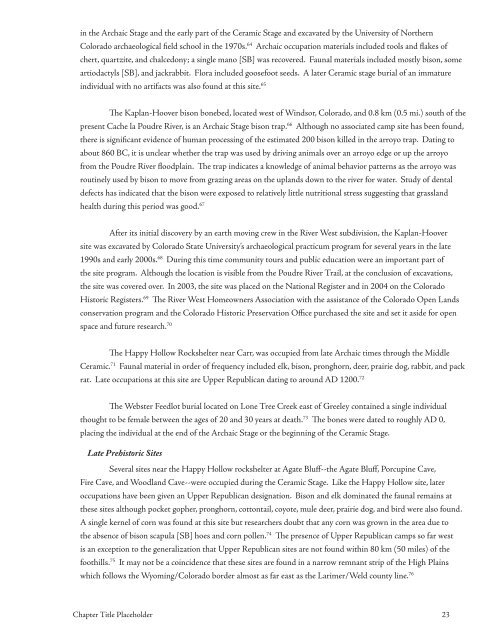People of the Poudre - Cache la Poudre National Heritage Area
People of the Poudre - Cache la Poudre National Heritage Area
People of the Poudre - Cache la Poudre National Heritage Area
Create successful ePaper yourself
Turn your PDF publications into a flip-book with our unique Google optimized e-Paper software.
in <strong>the</strong> Archaic Stage and <strong>the</strong> early part <strong>of</strong> <strong>the</strong> Ceramic Stage and excavated by <strong>the</strong> University <strong>of</strong> Nor<strong>the</strong>rnColorado archaeological field school in <strong>the</strong> 1970s. 64 Archaic occupation materials included tools and f<strong>la</strong>kes <strong>of</strong>chert, quartzite, and chalcedony; a single mano [SB] was recovered. Faunal materials included mostly bison, someartiodactyls [SB], and jackrabbit. Flora included goosefoot seeds. A <strong>la</strong>ter Ceramic stage burial <strong>of</strong> an immatureindividual with no artifacts was also found at this site. 65The Kap<strong>la</strong>n-Hoover bison bonebed, located west <strong>of</strong> Windsor, Colorado, and 0.8 km (0.5 mi.) south <strong>of</strong> <strong>the</strong>present <strong>Cache</strong> <strong>la</strong> <strong>Poudre</strong> River, is an Archaic Stage bison trap. 66 Although no associated camp site has been found,<strong>the</strong>re is significant evidence <strong>of</strong> human processing <strong>of</strong> <strong>the</strong> estimated 200 bison killed in <strong>the</strong> arroyo trap. Dating toabout 860 BC, it is unclear whe<strong>the</strong>r <strong>the</strong> trap was used by driving animals over an arroyo edge or up <strong>the</strong> arroy<strong>of</strong>rom <strong>the</strong> <strong>Poudre</strong> River floodp<strong>la</strong>in. The trap indicates a knowledge <strong>of</strong> animal behavior patterns as <strong>the</strong> arroyo wasroutinely used by bison to move from grazing areas on <strong>the</strong> up<strong>la</strong>nds down to <strong>the</strong> river for water. Study <strong>of</strong> dentaldefects has indicated that <strong>the</strong> bison were exposed to re<strong>la</strong>tively little nutritional stress suggesting that grass<strong>la</strong>ndhealth during this period was good. 67After its initial discovery by an earth moving crew in <strong>the</strong> River West subdivision, <strong>the</strong> Kap<strong>la</strong>n-Hooversite was excavated by Colorado State University’s archaeological practicum program for several years in <strong>the</strong> <strong>la</strong>te1990s and early 2000s. 68 During this time community tours and public education were an important part <strong>of</strong><strong>the</strong> site program. Although <strong>the</strong> location is visible from <strong>the</strong> <strong>Poudre</strong> River Trail, at <strong>the</strong> conclusion <strong>of</strong> excavations,<strong>the</strong> site was covered over. In 2003, <strong>the</strong> site was p<strong>la</strong>ced on <strong>the</strong> <strong>National</strong> Register and in 2004 on <strong>the</strong> ColoradoHistoric Registers. 69 The River West Homeowners Association with <strong>the</strong> assistance <strong>of</strong> <strong>the</strong> Colorado Open Landsconservation program and <strong>the</strong> Colorado Historic Preservation Office purchased <strong>the</strong> site and set it aside for openspace and future research. 70The Happy Hollow Rockshelter near Carr, was occupied from <strong>la</strong>te Archaic times through <strong>the</strong> MiddleCeramic. 71 Faunal material in order <strong>of</strong> frequency included elk, bison, pronghorn, deer, prairie dog, rabbit, and packrat. Late occupations at this site are Upper Republican dating to around AD 1200. 72The Webster Feedlot burial located on Lone Tree Creek east <strong>of</strong> Greeley contained a single individualthought to be female between <strong>the</strong> ages <strong>of</strong> 20 and 30 years at death. 73 The bones were dated to roughly AD 0,p<strong>la</strong>cing <strong>the</strong> individual at <strong>the</strong> end <strong>of</strong> <strong>the</strong> Archaic Stage or <strong>the</strong> beginning <strong>of</strong> <strong>the</strong> Ceramic Stage.Late Prehistoric SitesSeveral sites near <strong>the</strong> Happy Hollow rockshelter at Agate Bluff--<strong>the</strong> Agate Bluff, Porcupine Cave,Fire Cave, and Wood<strong>la</strong>nd Cave--were occupied during <strong>the</strong> Ceramic Stage. Like <strong>the</strong> Happy Hollow site, <strong>la</strong>teroccupations have been given an Upper Republican designation. Bison and elk dominated <strong>the</strong> faunal remains at<strong>the</strong>se sites although pocket gopher, pronghorn, cottontail, coyote, mule deer, prairie dog, and bird were also found.A single kernel <strong>of</strong> corn was found at this site but researchers doubt that any corn was grown in <strong>the</strong> area due to<strong>the</strong> absence <strong>of</strong> bison scapu<strong>la</strong> [SB] hoes and corn pollen. 74 The presence <strong>of</strong> Upper Republican camps so far westis an exception to <strong>the</strong> generalization that Upper Republican sites are not found within 80 km (50 miles) <strong>of</strong> <strong>the</strong>foothills. 75 It may not be a coincidence that <strong>the</strong>se sites are found in a narrow remnant strip <strong>of</strong> <strong>the</strong> High P<strong>la</strong>inswhich follows <strong>the</strong> Wyoming/Colorado border almost as far east as <strong>the</strong> Larimer/Weld county line. 76Chapter Title P<strong>la</strong>ceholder


